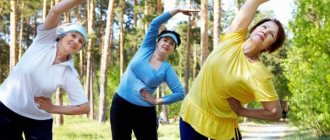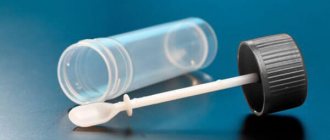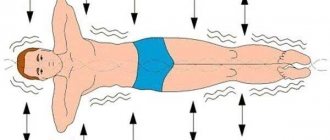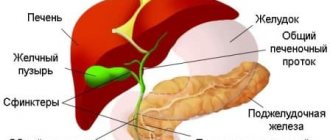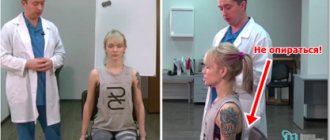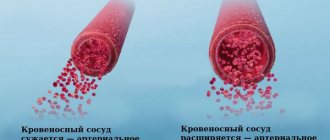Exercise therapy complex for hypotension
For gymnastics to be effective, you must follow simple rules:
- Conduct physical education regularly and systematically. Alternate physical activity, such as dumbbells, and exercises.
- Increase physical activity gradually over a long period of exercise. A minimum of 2 months is required. Don't set the bar high. The increase should be gradual.
As a result of physical exercises:
- Improves blood circulation.
- Stimulates metabolism.
- Supports the body's respiratory system.
Hypotonic patients complain of dizziness and headaches, so it is better to do exercises while lying down.
- Lying on the mat, lift and lower your legs in space.
- Raise your lower limbs in the air, bend your knees and make movements like on a bicycle.
- Raise your lower limbs up and cross them in the air.
- Raise your arms with dumbbells up and down.
- Raise your free arms quickly up and down without dumbbells.
- Bend your lower limbs at the knees, press them to your chest and clasp them with your arms. Now you need to forcefully free yourself from your hands and straighten your lower limbs.
Walking in place is the best exercise for hypotension :
- Start walking in place for two minutes at a slow pace, and then at a fast pace.
- Stretch your arms forward and clench into fists. Walk quickly, while bending and unbending your fists.
- Spread your arms to the sides, walk at a medium rhythm.
- We do a similar exercise with raised arms.
- Place your hands at the waist, raise your legs on your toes, and perform steps in place at an average rhythm for one minute.
- Do the same movement, leaning on your heels.
- Move your body forward, arms at the waist, bend your knees. Move for 15 seconds, half sitting.
- Walk at a slow pace for 30 seconds.
- Walk for two minutes with wide arm swings.
- Swing your left leg forward, backward, right and left, then right.
- Place your feet at shoulder level, gradually lower your arms, touch the floor. We do the same movement with our legs together.
Treatment of hypotension at home
How to live with low blood pressure
Arterial hypotension - a decrease in blood pressure by more than 20% from the initial/usual values or in absolute numbers - below 90 mm Hg. Art. systolic pressure or 60 mm Hg. mean arterial pressure.
The following types of arterial hypotension are distinguished:
- Acute arterial hypotension
- Chronic arterial hypotension
- Primary chronic arterial hypotension
- Secondary chronic arterial hypotension
Acute symptomatic hypotension (sharp drop in pressure). For example, very low blood pressure is often accompanied by acute myocardial infarction, pulmonary embolism, severe arrhythmias, intracardiac blockades, allergic reactions, blood loss, etc. Emergency medical care is required.
Physiological (chronic) hypotension manifests itself in trained athletes and as a hereditary predisposition to low blood pressure, which does not go beyond normal limits.
Primary (otherwise known as idiopathic or essential) hypotension is an independent disease.
According to one theory, primary hypotension is a special form of neurosis-like disease of the vasomotor centers of the brain, since prolonged psycho-emotional stress and stress may play a very large role in its development.
Secondary arterial hypotension occurs against the background of other diseases (for example, osteochondrosis of the cervical spine, stomach ulcers, anemia, hepatitis, pancreatitis, cystitis, tuberculosis, rheumatism), arrhythmias, alcoholism, diabetes, diseases of the endocrine system or respiratory organs, tumors, shock, brain injuries, liver cirrhosis, mental trauma, circulatory disorders, heart failure, intoxication, as a side effect of certain medications (for example, their overdose in the treatment of hypertension), etc.
Hypotension can also develop due to fasting and lack of vitamins E, C, B and pantothenic acid (B5), in athletes with constant physical activity. This is the so-called “training hypotension.” In this case, low blood pressure acts as a kind of protective measure for the body. It turns out that with constant overload, the body begins to work in an “economy” mode, the heart rate becomes less frequent and the pressure drops.
Pressure also decreases when a person adapts to a sudden change in climatic or weather conditions. In addition, the pressure level is affected by: increased humidity, the influence of electromagnetic fields, radiation, etc.
Most often, low blood pressure is associated with impaired vascular tone. Normally, vessels should quickly narrow and dilate when necessary, but in hypotensive patients this reaction is slowed down. So it turns out that because of this, blood stops flowing in sufficient quantities to organs and tissues. As a result, the body's systems and organs, in particular the brain and heart, experience oxygen starvation and are unable to function optimally.
How does hypotension manifest?
Hypotension does not always mean illness. Some people, having constant low blood pressure, feel great, and for them it is normal, while others constantly suffer. Symptoms of low blood pressure include:
- feeling of fatigue, weakness, decreased performance;
- headache; usually dull, constricting, bursting or pulsating, more often in the frontotemporal or frontoparietal region;
- dizziness and fainting;
- intolerance to stuffiness;
- insomnia;
- increased irritability
- irritability;
- sensitivity to weather changes;
- emotional instability, apathy;
- increased sweating;
- violation of thermoregulation (cold hands and feet);
- tendency to motion sickness, nausea.
Interestingly, the time of day is of great importance for the well-being of hypotensive patients. So, they get out of bed sleep-deprived and exhausted, then, after an hour or two, they come to their senses. During the day, their performance drops again, but by the evening they are again cheerful and ready for a feat.
Hypotonic people love cold weather more, since they tolerate cold much better than heat. It is especially difficult for them in public transport, in a crowd - the stuffiness makes them feel dizzy and headaches, they may even faint. Fainting can also be caused by a sudden rise from a lying position, especially in the morning after sleep. The state of health of a hypotensive person worsens both after a heavy meal and after a strong emotional shock.
How to live with hypotension
If hypotension was a manifestation of another disease, then, naturally, it is necessary to be treated for it.
With primary hypotension, you first need to pay attention to lifestyle.
If possible, it is better to adjust your daily routine to your well-being: sleep longer in the morning, perhaps lie down for a couple of hours in the afternoon, planning the main tasks for the second half of the day, when you feel cheerful and rested. Unfortunately, not everyone can afford such a routine.
But anyone can train blood vessels. After all, it is their reduced tone that is the cause of all the troubles of hypotension. Pouring cool water with a gradual decrease in its temperature or a contrast shower are suitable for this, but the transition from heat to cold should not be abrupt, but smooth.
Coffee is believed to be a tonic. If it helps you cheer up, you can drink it, but you shouldn’t get too carried away - two or three cups a day are enough. You can try to improve vascular tone with green tea, only real tea, brewed, and not in bags.
Since a large meal is difficult for a hypotensive person, it is advisable to eat in small portions, but more often. And the diet must contain animal proteins.
The first friend of a hypotensive person is fresh air. Often a simple walk can help get rid of a headache. Walk more often, walk, if possible, sleep with an open window or vent, or at least ventilate the bedroom well at night.
And of course, physical activity is vital for those suffering from low blood pressure. This could be a set of exercises (only without sudden head movements), skiing, cycling, or exercise in the pool. But all this is without fanaticism - the load should be moderate.
Simple and banal, however, you should not neglect these simple recommendations - they will really make the life of a hypotensive patient more comfortable.
Doctor - therapist (precinct) 2nd ter. departments
Belevich Elena Alexandrovna
Learning to breathe correctly
Maintaining a breathing rhythm is an important point during physical exercise.
Correct breathing:
- Through the nose.
- Application of the lower respiratory organs.
- Combining a jerk with an inhalation.
Yoga classes teach you how to breathe correctly. A person can use three types of breathing: upper, middle and lower.
So, what breathing can be used for hypotension:
- Abdominal breathing. In it, we exclude the chest muscles, take a breath, expanding the abdominal area. As you exhale, draw your stomach in as much as possible. Do the exercise 12-15 times.
- Chest breathing. We inhale and expand the chest, while exhaling we release it to the maximum.
- Breathing with the diaphragm. This requires using the diaphragm and chest muscles.
In order to learn rhythmic breathing, you should do the following exercise:
- Inhale for two seconds, exhale for four seconds.
- Add one second to each inhalation, and two seconds to the exhalation.
- We bring the inhalation time to five seconds, and the exhalation will be ten seconds.
Exercise therapy for hypotension with a set of exercises will help eliminate the causes of hypotension. You can add proper nutrition and walks in the fresh air to the complex.
Why is physical therapy needed?
Hypotension is a disease characterized by low blood pressure (90/60 and below). Hypotension can be observed not only due to dysfunction of the cardiovascular system, but also in the presence of concomitant diseases. Low blood pressure is common in people who actively engage in sports.
In some cases, hypotension is congenital. In such cases, the patient usually feels great even with low blood pressure. Low blood pressure is most common in females, especially in the period before the upcoming menstruation.
Regardless of the cause of the pathology, doctors recommend that their patients lead an active lifestyle and perform some exercises that are aimed at improving well-being during hypotension.
Constantly performing exercise therapy for hypotension improves blood circulation, the supply of blood and oxygen to the brain tissues. A course of physical therapy allows you to get rid of or minimize the unpleasant symptoms of the disease.
Exercises for children
Not only adults, but also children are susceptible to low blood pressure. Physical exercises, in other words morning exercises, are recommended for children of all ages. If you start strengthening blood vessels from childhood, the symptoms of the disease can be eliminated at an older age. You should definitely visit a doctor and discuss which exercises will be most relevant for your child. Typically a set of exercises consists of the following:
- Stand on your heels and walk for a minute.
- Stand up on feet. Feet shoulder width apart. With our hands we aim for our toes. First with the right hand to the right leg, then with the left hand to the left leg.
- We stand on the floor, hands on the belt. We perform rotational movements with the torso.
- We get to our feet, hands on our belts. Performed head movements. Head down, up, left, right.
- We alternately jump on the left and right legs for one minute.
- We get on all fours and bend our back down, then up. Perform the exercise for 4 minutes.
- We lie down on the floor with our stomach down. We try to reach the heels with our hands.
- We get down on our knees. In this position we move around the room for several minutes.
- Stand up straight, take the stick in your left hand. We pull our left hand to the right, at the same time we pull our right leg in the opposite direction.
- We lie on our backs, bend our legs at the knees. We try to lift our torso off the floor and bring our chest closer to our knees.
These exercises can only be performed with the permission of the attending physician. Depending on the age of the child, the exercises can be replaced with simpler ones.
In order to effectively get rid of the unpleasant symptoms of hypotension, in addition to performing physical therapy, the doctor prescribes some medications. It is also recommended to follow general doctor's recommendations and preventive measures.
These include daily walks in the fresh air, a balanced diet and proper rest. If you notice that your blood pressure level regularly drops below 90/60, you should consult a doctor, undergo the necessary diagnostics and begin treatment.
Breathing during exercise
In order for exercises to become effective and bring maximum benefits to the body, you need to practice proper breathing during physical activity. The opinion of many doctors agreed on one thing: when performing physical gymnastics, it is advisable to breathe through the nose. Motor movements and breathing must be performed in rhythm.
In addition to physical therapy, there is breathing exercises, which are no less effective in the fight against low blood pressure. Doctors recommend comparing both types of gymnastics; breathing should be done twice: before and after physical activity.
To strengthen the lungs and develop the respiratory system, it is recommended to use various types of breathing. Let's take a closer look:
- Breathing using the diaphragm. This type of breathing involves inhaling simultaneously from the chest and diaphragm. When exhaling, you need to squeeze your pectoral muscles and diaphragm at the same time.
- Breathing through the chest. When inhaling air, we try to expand the chest and fill it with air. When exhaling, we compress the chest and release the air through the nose.
- Abdominal breathing. This technique involves breathing using the abdominal cavity. Inhaling air as much as possible, we try to fill the stomach with air, and when exhaling, the stomach needs to be drawn in.
